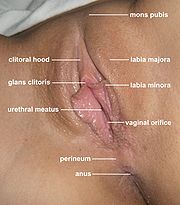- Labia minora
-
Labia minora 
Labia minora (inner labia); hair has been removed Latin labium minus pudendi Gray's subject #270 1265 Precursor Urogenital folds Dorlands/Elsevier Labia minora pudendi The labia minora (singular: labium minus), also known as the inner labia, inner lips, or nymphae,[1] are two flaps of skin on either side of the human vaginal opening, situated between the labia majora (outer labia, or outer lips). Inner lips vary widely in size, colour, and shape from woman to woman.
The inner lips extend from the clitoris obliquely downward, laterally, and backward on either side of the vulval vestibule, ending between the bottom of the vulval vestibule and the outer lips. The posterior ends (bottom) of the inner lips are usually joined across the middle line by a fold of skin, named the frenulum labiorum pudendi or fourchette.
On the front, each lip divides into two portions. The upper part of each lip passes above the clitoris to meet the upper part of the other lip—which will probably be a little larger or smaller—forming a fold which overhangs the glans clitoridis; this fold is named the preputium clitoridis. The lower part passes beneath the glans clitoridis and becomes united to its under surface, forming, with the inner lip of the opposite side, the frenulum clitoridis.
On the opposed surfaces of the labia minora are numerous sebaceous glands not associated with hair follicles.
Contents
Size and shape
In or around 2004, researchers from the Department of Gynaeology, Elizabeth Garret Anderson Hospital in London, measured the labia and other genital structures of 50 women from the age of 18 to 50, with a mean age of 35.6. The results were:[2]
Measuring Range Mean [SD] Clitoral length (mm) 5–35 19.1 [8.7] Clitoral glans width (mm) 3–10 5.5 [1.7] Clitoris to urethra (mm) 16–45 28.5 [7.1] Labia majora length (cm) 7.0–12.0 9.3 [1.3] Labia minora length (mm) 20–100 60.6 [17.2] Labia minora width (mm) 7–50 21.8 [9.4] Perineum length (mm) 15–55 31.3 [8.5] Vaginal length (cm) 6.5–12.5 9.6 [1.5] Tanner stage (n) IV 4 ditto V 46 Colour of genital area compared with surrounding skin (n)
Same 9 ditto Darker 41 Rugosity of labia (n) Smooth 14 ditto Moderate 34 ditto Marked 2 Additional images
See also
References
- ^ nymphae. Dictionary.com. Merriam-Webster's Medical Dictionary. Merriam-Webster, Inc. (accessed: November 24, 2007).
- ^ Lloyd, Jillian et al. "Female genital appearance: 'normality' unfolds", British Journal of Obstetrics and Gynaecology, May 2005, Vol. 112, pp. 643–646. PMID 15842291
External links
- labium+minus at eMedicine Dictionary
This article was originally based on an entry from a public domain edition of Gray's Anatomy. As such, some of the information contained within it may be outdated.
Female reproductive system (TA A09.1–2, TH H3.07.01, GA 11.1254) Internal Adnexacorpus (hemorrhagicum, luteum, albicans) · Theca of follicle (externa, interna) · Follicular antrum (Follicular fluid) · Corona radiata · Zona pellucida · Membrana granulosa · Perivitelline spaceOtherProper of ovary · Suspensory of ovarycorpus/body (Uterine cavity, Fundus) · cervix/neck (External orifice, Canal of the cervix, Internal orifice, Supravaginal portion of cervix, Vaginal portion of cervix, Cervical ectropion) · Uterine hornsGeneralExternal Mons pubis · Labia majora (Anterior commissure, Posterior commissure) · Pudendal cleft · Labia minora (Frenulum of labia minora, Frenulum of clitoris) · Vulval vestibule · Interlabial sulci · Bulb of vestibule · Vaginal orifice
vestibular glands/ducts (Bartholin's glands/Bartholin's ducts, Skene's glands/Skene's ducts)Other Categories:- Female reproductive system
- Genitourinary system stubs
Wikimedia Foundation. 2010.


